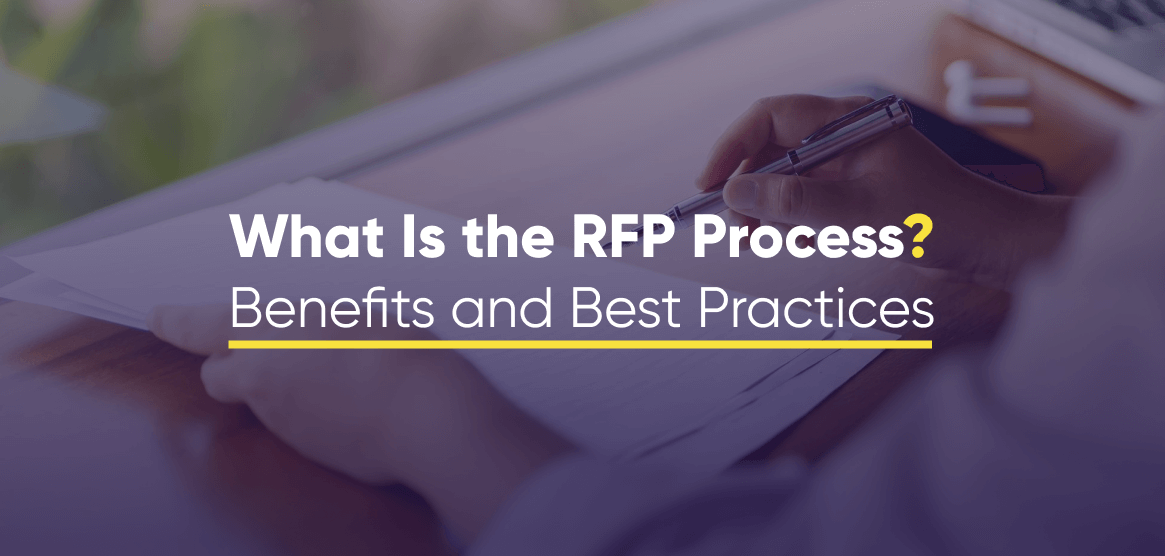What is an RFP process? How does it work? How long will it take? As a beginner, or someone who’s not yet fully familiar with the RFP process, it’s important to familiarize yourself with the first steps and gradually build your knowledge.
Today we’ll start with the most frequently asked questions, the benefits of issuing an RFP, and its key phases. After this, we’ll give you a few useful tips on issuing a loyalty program RFP (based on what we’ve seen as a vendor), highlight certain topics you should consider including, and at the end, we’ll show you example questions as well.
In case you’re already familiar with the basics of the RFP process, and just looking for inspiration to write your own, why not download our ready-made RFP worksheet? It features over 100 questions aimed at not just loyalty technology vendors, but SaaS marketing companies in general.
Table of Contents
Frequently Asked Questions About the RFP Process
What Is an RFP?
RFP stands for Request for Proposal. It’s a central element in an official, Q&A-style business document.
What Does the RFP Process Stand for in Business?
During the RFP process, a solicitation is sent out to a select number of technology providers, requesting a formal proposal from them, regarding an upcoming project. It contains the context for the project, a set of questions about the vendor’s capabilities, and submission guidelines. It is usually issued by bigger companies, enterprises or government agencies.
Is an RFP a Contract?
No. An RFP is not a contract, it is only a request for a formal proposal from technology vendors.
What Is the Purpose of an RFP Process?
It provides the appropriate framework for companies to effectively compare vendor proposals and enables them to select the technology provider, whose capabilities, terms, and conditions fit the company’s requirements the most.
How Long Does an RFP Process Take?
It’s safe to say that the entire RFP process is not an overnight occurrence. It fully depends on the company, but generally, we can say that it takes anywhere between a few weeks to half a year or even longer.
What Are the Benefits of Running an RFP?
1. Helps you align the project
2. Quicker vendor selection
3. Better overview of vendor USPs
4. Minimizes additional consultation later
5. Provides financial clarity
How to Write a Loyalty Program RFP – If Only There Was a Course You Could Take
Additionally to the general framework of any request for proposal in the B2B buying process, every loyalty program RFP should include industry-specific details and requirements as well. These are highly specific for each company, the following are only general suggestions.
Suggested topics:
- Information about whether it’s a brand new loyalty program project, a revamp, redesign, or a complete overhaul of an existing one.
- Details about particular areas you would like to improve in case it’s a revamp.
- What channels the loyalty program will focus on, or what specific features you would be interested in including.
As we’ve mentioned you have to make sure to truly tailor your question to your specific needs. Our Antavo Academy course on Loyalty vendor selection & RFP (you can easily select this from our Antavo Academy Home Page, without having to enroll) will also provide you with the necessary information about how you can start, and possibly which topics you should include in your request.
It is a course designed to lead you through the general steps of the vendor selection and RFP process, offering practical advice, interactive questions, and examples for better understanding. It encourages you to truly think about the logical order of important steps, reinforcing full comprehension of the subject. You will also have the chance to put your newfound knowledge to the test immediately.
What Is the Difference Between an RFI and an RFP?
- RFI (meaning Request for Information) is also a formal document sent out to technology vendors. The difference is, that an RFI is much more high-level, containing open-ended questions, mostly asking vendors to outline their capabilities not going into technical details and other specifications.
- RFP (meaning Request for Proposal) is an in-depth, detailed, and systematic request for bid, sent out to a narrowed-down list of technology vendors. It contains specific information about the context, scope, budget, and timeline of the project.
What Are the Phases of the RFP Process?
We could generally divide the entire RFP Process into 6 phases. Each one has its own time requirements, so make sure to kick off the project early on, so it can align with your business goals. The added durations can vary depending on specific use cases.
#1. Setting goals, reaching internal alignment (2-3 weeks)
It’s the time to do internal research. Most importantly, since the RFP is a procurement process, involving the procurement team early on is a must. Plus, it is additionally worth it to ask for strategic input and technological requirements from connected departments and stakeholders.
#2. Creating and issuing your RFP template (1-2 weeks)
After clarifying your goals and requirements it’s time to create the actual RFP template, and send it out to the selected vendors, or publish it on your website for vendors to find (don’t forget to set a submission deadline even in the latter case).
#3. Receiving the offers and the first round of evaluation (6-8 weeks including submission deadlines)
A Q&A-style RFP worksheet (that can be used a template as well) makes the evaluation process a lot easier, saving you tons of time. You can clearly compare and eliminate prospects based on your criteria. We recommend narrowing down the list to the 2 most promising candidates.
#4. RFP presentation meeting (RFP sales pitch by vendors) (1 week)
When we are talking specifically about loyalty platforms, there is usually a period after the proposals come in, when potential technology partners hold a brief company overview. It consists of a platform demonstration and a high-level technical platform overview. This helps in the overall process of making the final decision.
#5. Making the final decision (2-3 weeks depending on additional agreement and verification)
Making the final decision is not always easy, which is why spending sufficient time on creating the right questions is so important. After you’ve received the submissions, and narrowed down the list, be prepared to have an additional round as well. In our free Antavo Academy vendor selection and RFP course, we’ll show a few examples of the type of documents you should additionally ask for.
#6. Contracting (1 week)
Having received all the necessary information, the final steps of the process are incredibly important. You have to both look at the big picture and analyze the small details to be able to come up with the right answer and start the contracting process. During our course, you’ll be able to learn which pain points need extra attention.
5 RFP Process Best Practices You Didn’t Know About
In the B2B buying process, there’s no standardized template for writing and issuing an RFP because each company has its own needs and priorities. Nevertheless, we’ve picked out a few key details and best practices from our experience working with RFPs (loyalty program RFPs to be exact).
This is a list of RFP best practices that you probably didn’t think about, but they can definitely make your work and the whole RFP process a lot easier.
- Appoint a dedicated key point of contact for the RFP: This might not be an obvious task at first, having so many people involved in the project, but it can help streamline operations very effectively. Also, it is not a short-term project, so having a full-time supervisor is advised.
- Issue an RFI first: This helps with general information gathering and enables you to narrow down the list of potential candidates. Plus, it’s the perfect way to get to know the vendors a bit before sending your RFPs out of the blue.
- Dedicate a section specifically to your strategic goals: By clarifying exactly what you would like to achieve by using their software, vendors can create a more targeted, more realistic, and more pragmatic proposal for you.
- Take time to communicate with the vendors in separate channels: Instead of having a shared platform, take time to pay attention to each vendor individually, to avoid non-relevant feedback and confusion by cross-answering questions.
- Actively encourage vendors to show off their expertise: You can also potentially ask them to set up an extensive roadmap for the future as well.
To learn more about how you can effectively compare loyalty program providers check out our downloadable Comparison Worksheet.
Enterprise vs. Mid-Level RFPs: What’s the Difference?
Having received our fair share of RFPs over the years, we’ve come to realize that not all RFPs need the same approach. The key is knowing what kind of organization you are and right-sizing the process accordingly. Here’s how we break it down internally:
Enterprise-Level RFP:
A high-stakes, multi-market, or cross-departmental initiative — the kind that needs a rock-solid foundation and sign-off from half the org chart.
- Lots of stakeholder input: Procurement, legal, IT, marketing, data teams — they all weigh in.
- Extensive documentation: Deep on requirements — everything from system architecture to data privacy to global scalability.
- Longer runway: At least 4–6 months from initial prep to final decision.
- Formal vendor process: Multiple rounds, scorecards, internal review loops — the whole works.
- Large-scale vetting: Looking at financial health, customer references, even roadmap alignment.
Mid-Level RFP:
This is more about speed and specificity. Maybe it’s a regional program upgrade or a time-sensitive rollout — the scope is narrower, but still strategic.
- Smaller team, faster feedback: Usually driven by one department, with fewer cooks in the kitchen.
- Lean but clear requirements: Enough detail to get apples-to-apples proposals, without overloading vendors.
- Quick turnaround: From draft to decision within 6–10 weeks.
- More flexibility: Open to working sessions, tailored demos, and creative problem-solving.
- ROI matters more than bells & whistles: Focused on outcomes, speed to value, and a partner who understands the goals.
Important Details You Should Pay Attention to When Sending Out Your RFP Invitation Emails
After your requested RFIs come in, and you’ve selected a handful of potential technology vendors, the next step in your RFP process is to put together the RFP package itself. An important part of this is the actual invitation email.
What you need to pay attention to here are a few technical elements, such as complying with privacy regulations. You have to send out the emails adding your recipients to BCC (it stands for Blind Carbon Copy, so they won’t see each other), eliminate grammatical errors, and pay attention to addressing them correctly.
Plus, you have to take meticulous care with the attachments themselves as well. Make sure to utilize everything you’ve learned during our Antavo Academy course, so you won’t miss out on including anything crucial.
We Always Welcome Your RFP
There’s nothing else left to say, the only way is forward from now on. We are sure you’re excited to start your vendor selection journey and sincerely hope that this article and every additional material listed was helpful to you.
In case you need additional help with research, we offer numerous industry-related guides, many more easy-to-use downloadable worksheets, and a wide spectrum of Antavo Academy courses as well.
And, if you’re interested in having Antavo participate in your RFP, reach out to us by booking a demo.
Also make sure to check out the downloadable RFP Worksheet, to help you kick-start your vendor selection journey
Zsuzsanna is a Loyalty Specialist and Certified Loyalty Expert™ with years of experience in digital marketing and e-commerce. Zsuzsanna is known for having an analytic approach and high-level communication skills, helping her deliver engaging content. In her free time, she enjoys watching Formula 1 and listening to endless Taylor Swift playlists.


